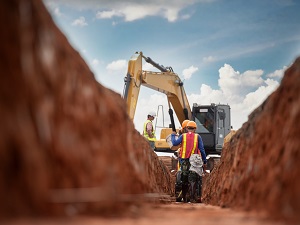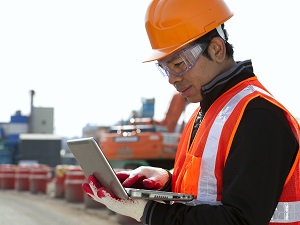Here’s a review of 5 of the more common safety hazards that contractors and their workers need to be aware of at the construction site. A robust safety program will help minimize risk to your workforce and keeping your insurance up to date will help your company weather any future liabilities.
Construction site safety is one of the biggest challenges that contractors face. Every contractor needs to implement stringent safety rules for the job site to protect employees and, of course, have sufficient contractor’s insurance to take care of any liabilities.
Whether you own a construction business or subcontract for much larger companies, these are the construction site risks that you should be aware of to protect your workforce and bottom line.

Slips and Falls
Did you know that falling incidents account for about a third of deaths in the construction industry each year? Slips and falls are two of the most common causes of on-site injuries, but despite this being a well-known fact, many contractors still have to deal with slip and fall incidents all the time.
As contractors, one of the best things you can do to minimize the casualties of fall incidents is to provide your employees with personal protective equipment and make sure they receive proper training on how to use them.
If there are people working at height or about 6 feet above another surface, they should have fall protection equipment such as guardrails, restraint and safety arrest systems, covers, and etc. Also, don’t forget to perform routine checks on surfaces, walkways, ladders, and scaffolds to see if they meet stability and standard safety requirements.

Heavy Equipment
Moving objects are an inherent hazard in the constantly-changing construction environment. The sheer volume of people, vehicles, and equipment that are transporting materials and heavy loads from one area to another – and usually on uneven terrain, at that – pose potential dangers to everybody on site.
Being struck by objects is the second major cause of construction site deaths. And moving objects, particularly those that lift and carry heavy loads such as vehicles, cranes, and forklifts account for a large chunk of these deaths.
There are several steps that contractors can take to protect and keep their workforce safe from moving objects. The first, of course, is to require everybody to wear head protection at all times and (if possible) high-visibility clothing, too. Secondly, only employees with proper training/certification should be allowed to operate heavy equipment and machinery.
As vehicle hazards make up a good fraction of these incidents, establishing clear routes for vehicles on site will also help employees know where to position themselves when moving around.

Trenching and Excavation
A lot of construction workers get seriously injured in excavation and trenching incidents every year. Given the amount of risk, contractors need to plan and implement proper precautions for collapse before starting any kind of work that requires trenches. For one, extra measures should be taken to ensure that trenches are fully secure. This includes regular inspections, both before and during the shift, and installing professionally-designed protective systems and wall support for deeper trenches. There should also be trench exits every 20-25 feet away from any point in the trench. Most importantly, all workers must undergo comprehensive training on how to protect themselves in the event of a trenching incident.

Electrical Hazards
Despite being aware of the dangers of electricity, thousands of construction site workers still get hurt or injured due to electrical safety issues. Working with machinery, power tools, and electrical wiring on a day to day basis puts construction workers at constant risk of electrocution and electrical burns. Most of them sustain injuries from accidentally touching live parts or through a conducting object. But while most of these incidents happen inadvertently, they can be prevented with simple and basic precautionary measures.
Proper head protection gear will protect you against some perils in the construction site. Thus, employees must be provided with hard hats that meet consensus standards. Moreover, they should be reminded to always identify utilities and power lines before starting work or operating equipment. Using double insulated portable tools and having ground fault circuit interrupters onsite are also effective ways of avoiding electrical-related hazards.

Third-Party Injuries
If construction site employees who are already equipped with industry knowledge, experience, and extensive training are still at risk every day that they show up on site, then how much more are the visitors who are basically clueless of how things work?
While construction sites are usually off-limits to outsiders, guests – most probably the owners, investors, or buyers – may still come to visit or check the progress at random days. Everybody working on the build already knows that “safety first” is the golden rule, but as the contractor, you’re also responsible for the safety of anyone who steps inside the premises.
To minimize the risk of guest injuries, always require visitors to wear safety equipment such as hard hats and safety vests. You should also take measures to control the job site through alarms, motion sensors, fencing, or other building enclosures. In addition, children should not be allowed to enter and, if possible, only allow visits by appointment.

Protecting Your Business Further
While rigorous safety practices help a lot in minimizing the chances of workplace incidents, they cannot protect everyone or prevent every type of incident.
Site incidents can cost contractors much more than liability claims. There’s the possibility of construction delays, work stoppages, reputation damage, plus other fees and penalties. That said, merely following safety standards won’t be enough to protect the business and employees in case something unfortunate does happen.
If you care about your venture and the welfare of your workforce, then make sure you have the right contractor’s insurance in place which may include general liability insurance, builders risk insurance, and workers compensation insurance. These policies will help you weather incidents and injuries, and many other liabilities that may come your way.


.jpg)
